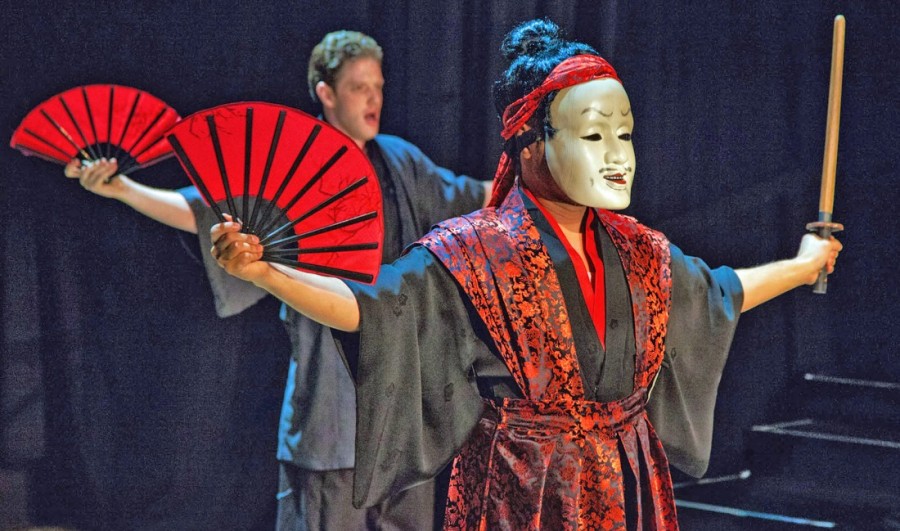
See What I Wanna See. Words and music by Michael John LaChiusa. 11th Hour Theatre Company, 2016
Michael John LaChiusa could have been thinking of the 2016 presidential campaign when he wrote See What I Wanna See. Not actually, because the musical premiered in 2005 at New York’s Public Theater. But its subject certainly is current: the sharp difference of opposing perspectives, and accusations of lying.
One of his characters says, “Folks are desperate. The more far-fetched the lies, the more some people will believe them.”
See What I Wanna See was inspired by the Kurosawa film Rashomon, about the subjective nature of truth which, in turn, was based on short stories by Ryunosuke Akutagawa. The opening seems like a scene from the Japanese movie. “Tonight I kiss my lover for the last time,” a woman sings as she prepares to kill her adulterous paramour with a dagger.
We hear a re-play, but now it’s sung by the man, and it’s he who holds the knife and prepares to kill.
We find ourselves outside the Manhattan theater where the movie had its 1951 premiere, and we learn that shortly after the audience left, a man was found dead in the nearby park.
The movie-theater’s janitor stumbled on the corpse on his way home from work. We hear his testimony to the police who want him to tell them something different from what he’s disclosing. He pleads with them, “Whatcha want me to say?” That line is echoed by other participants as they undergo questioning.
Numerous details of narrative reinforce the play’s point that people want to hear what they want to hear, and they choose to see what they want to see. (Just as political conservatives tune to Fox News while liberals watch MSNBC.)
We hear antithetical accounts of ambush, rape and murder from contradictory viewpoints, including the janitor, a thief, a wife and a husband. We even encounter a medium who channels the voice of the deceased. It’s fascinating to watch how the same characters become completely different people depending on who’s telling the story.
This complex interplay was written by Michael John LaChiusa, a composer, lyricist and librettist whose shows include Marie Christine, The Wild Party and Giant.
LaChiusa supplies an additional thought about the American electorate. The theater marquee has a letter missing, so the movie title appears as R SHOMON. LaChiusa’s protagonist muses whether the missing “A” could stand for “America” or “anger” or “assholes.”
His fascinating score incorporates Japanese sounds (with prominent writing for flute and percussion), Latin, jitterbug, rock ‘n’roll and blues. In Bruce Coughlin’s orchestration (heard on the Ghostlight CD of the original cast) we hear the differing piano styles of boogie-woogie like Meade Lux Lewis, stride like Willie “The Lion” Smith, and rockabilly like Jerry Lee Lewis—reflecting what might have been heard in 1951. Here the piano parts are played on keyboard by the musical director, Dan Kazemi, who leads a six-piece band.
The musical development is complicated but the tunes are catchy, which reveals that LaChiusa is in a class with Stephen Sondheim, although he has not yet received similar fame.
The second act is devoted to a story that has no connection with what came before, except the theme that people will believe what they want to believe.
A priest has lost his faith in God in the wake of the Twin Towers tragedy. He comes to share his aunt’s conviction that God, Christ and all other deities are frauds, and he intentionally fakes the coming of a miracle in order to taunt what he calls “gullible dopes.” Throngs of people believe his announcement and flock to see the event. When the moment arrives, many believe they’ve witnessed a revelation while the priest sees nothing.
The atheist aunt’s “The Greatest Practical Joke of All” is a hilarious song, yet I preferred the hard-edged and passionate music that surrounds the mysterious crime in Act I.
Five performers sang and acted multiple roles. Baritone Jake Blouch was spectacular as lover, husband and a Central Park derelict. Michael Philip O’Brien was strong as the mobster and a TV reporter. Nancie Sanderson sang powerfully as the medium and the aunt. Cara Noel Antosca made a vivid impression as a temptress and a drugged-out actress, while Billy Bustamente appealingly portrayed the janitor and the priest.
Megan Nicole O’Brien and Steve Pacek share credit for the concept, which was radically different from the New York production. They chose to use a long playing area between facing banks of seats, thus creating vast areas of space between the performers at one end versus the other. This accentuated the theme of polarized points of view.
An earlier and shorter article about this appeared in Broad Street Review
Please share your thoughts with us. Address to editor@theculturalcritic.com
Read other reviews on The Cultural Critic